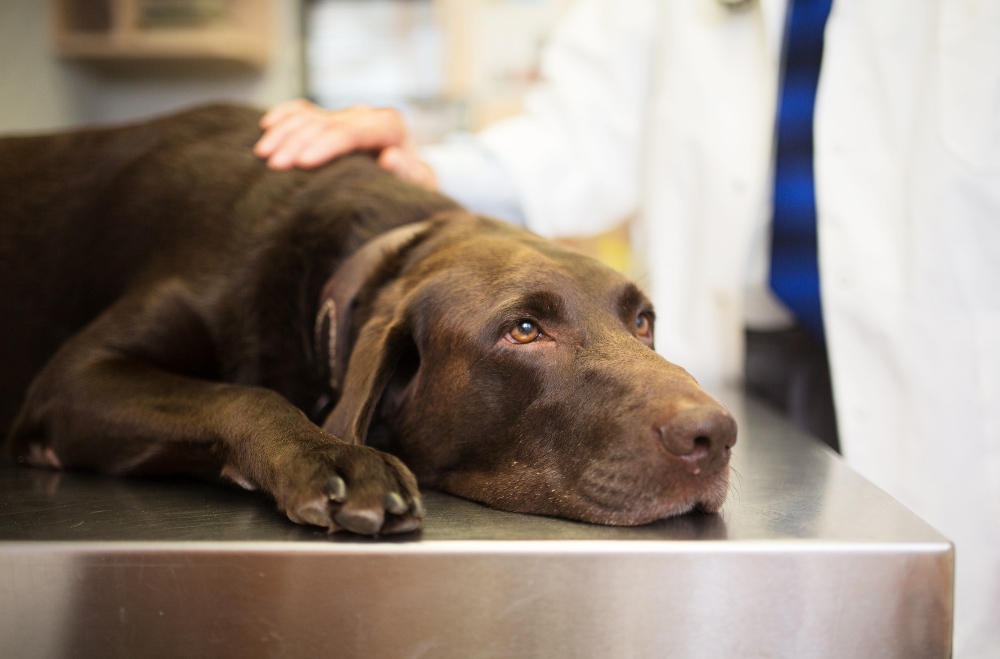Table of Contents
Canine Distemper is a disease that susceptible dogs may develop after exposure to the canine distemper virus (CDV). This viral disease is caused by a paramyxovirus and causes a wide array of symptoms in affected dogs. It is extremely contagious, but it is highly preventable.
How is it contracted?
Canine distemper is most commonly transmitted via respiratory droplets and saliva from infected dogs and certain wildlife. Urine and feces may also be infectious. Foxes, coyotes, raccoons, and skunks are a few examples of wildlife that may spread the virus. Dogs in close contact, such as those in boarding facilities or within the same household, are a concern as well. Affected animals may continue to harbor the virus for an extended period of time, which can make disease control difficult.
Which dogs are most at risk?
Unvaccinated puppies and adult dogs are more likely to contract this disease because they do not have the vital protection vaccines offer. Additionally, outdoor dogs are at an increased risk due to their higher likelihood of coming into contact with wildlife.
What are the symptoms of distemper?
Canine distemper affects the gastrointestinal, respiratory, and nervous systems. Signs of distemper can vary widely, and not all infected dogs experience the same symptoms. Symptoms can also vary greatly in severity, depending on how long the dog has been fighting the virus and how severe the infection is. Acute infection typically affects the respiratory and gastrointestinal tracts, while chronic infection leads to more neurological abnormalities.
General symptoms may include the following:
- Fever
- Vomiting
- Diarrhea
- Lack of appetite
- Weight loss
- Lethargy
- Dehydration
- Coughing
- Nasal discharge
- Eye discharge
- Increased respiratory rate
- Abnormal muscle movements
- Convulsions
- Seizures
Two highly characteristic signs of canine distemper also include thickening of the nose and paw pads and reduced enamel on the teeth.
How is it diagnosed?
Dogs with signs of illness should be brought to a veterinarian promptly for evaluation. After a thorough physical examination, your veterinarian will run bloodwork to check for abnormalities. Dogs with canine distemper typically have low white blood cell counts. If your veterinarian suspects this disease, additional samples may be collected to send to a laboratory that offers tests specifically for CDV.
What is the treatment?
Because there is currently no antiviral drug for this disease, treatment consists largely of supportive care. This means treatment is focused on helping affected dogs feel better. For example, dogs who are experiencing vomiting and diarrhea would greatly benefit from fluids, rest, and a bland diet. Dogs with respiratory symptoms may benefit from cough suppressants or oxygen support. Sometimes hospitalization is recommended. Medications that prevent seizures may also be helpful in some patients, while most dogs will receive an antibiotic to prevent secondary bacterial infections.
How can pet parents keep their dogs comfortable during treatment?
While recovering at home, dogs should be provided a quiet, private space to rest and recover. There should always be plenty of clean water available. Keeping infected dogs away from healthy dogs within the household is essential since this disease is highly contagious. This includes providing separate food and water dishes. Additionally, affected dogs should not visit dog parks or other public areas until they have fully recovered. It is important to always wash your hands after interacting with an infected dog to prevent transmitting the virus across surfaces or items within the home, which can spread the virus.
How much does treatment cost?
Treatment costs can vary greatly. Dogs who only experience mild symptoms may need less extensive treatment compared to those dogs who are severely ill. Treatment costs may range from $200-$2000 or more, especially if a dog requires extended hospitalization. Having pet insurance can help reduce the burden of these costs and help pet parents feel prepared for any unexpected costs that may arise throughout their dogs’ lives.
What is the prognosis?
If caught early, affected dogs may recover and live long lives. However, some symptoms, especially neurological signs, may linger for many months or years following the initial infection. Unfortunately, if caught too late in the course of the disease, distemper is usually fatal. It is reported that 50% of adult dogs and 80% of puppies will die from this disease [1].
How can pet parents prevent canine distemper in their dogs?
Staying up to date on vaccinations is the single most important way to prevent canine distemper. The DAPP vaccine, which stands for Distemper, Adenovirus, Parainfluenza, and Parvovirus is part of routine preventative care for all dogs. Puppies should receive initial vaccinations starting around 6 weeks of age followed by boosters every 3 weeks until they are 16 weeks of age. Then, a booster vaccination is given one year later and every three years thereafter. This is a highly effective vaccine and provides excellent protection to dogs.
Can humans get the canine distemper virus?
Fortunately, canine distemper is not a zoonotic disease, which means it cannot be transmitted from animals to humans.
References
- Cornell University College of Veterinary Medicine Animal Health Diagnostic Center. (n.d.). Canine Distemper. Ithaca, NY. Retrieved from https://cwhl.vet.cornell.edu/system/files/public/cwhl-fact-sheets-cdv.pdf








